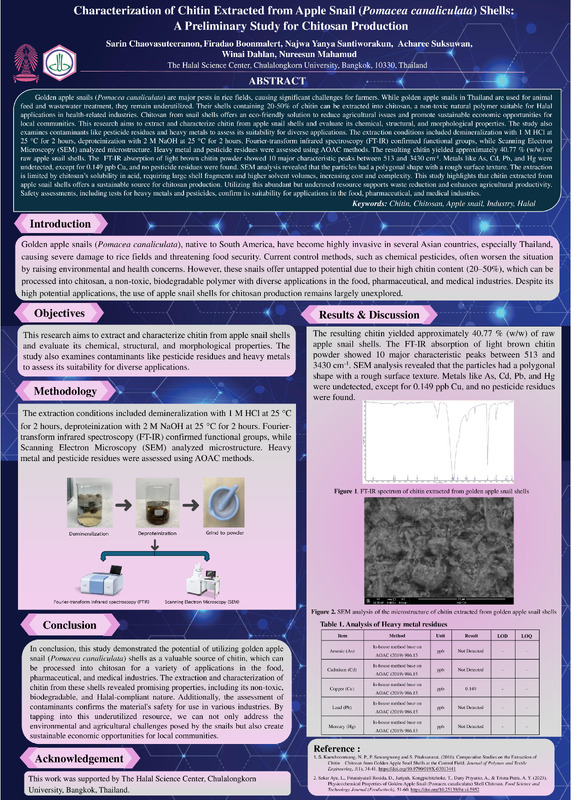-
Tittle
-
Characterization of Chitin Extracted from Apple Snail (Pomacea canaliculata) Shells: A Preliminary Study for Chitosan Production
-
Conference Acronym
-
IHSATEC 2024: 17th JHASIB
-
DOI Number
-
https://doi.org/10.31098/HST24148
-
Conference Date
-
December 19-20, 2024
-
presented at
-
The International Halal Science and Technology Conference 2024 (IHSATEC): 17th Halal Science Industry and Business (HASIB)
-
Poster Author(S)
-
Sarin Chaovasuteeranon, Firadao Boonmalert, Najwa Yanya Santiworakun, Acharee Suksuwan, Winai Dahlan, Nureesun Mahamud
The Halal Science Center, Chulalongkorn University, Bangkok, 10330, Thailand
-
Conference Theme
-
IHSATEC 2024: 17th HASIB
-
Abstract
-
Background – GGolden apple snails (Pomacea canaliculata) are major pests in rice fields, causing significant challenges for farmers. Chemical controls leave sharp residual shells, increasing risks of leptospirosis and medical costs. While golden apple snails in Thailand are used for animal feed and wastewater treatment, they remain underutilized. Their shells, containing 20-50% chitin, can be extracted into chitosan-a non-toxic natural polymer suitable for Halal applications in health-related industries. Chitosan from snail shells offers an eco-friendly solution to reduce agricultural issues and promote sustainable economic opportunities for local communities.
Purpose – This research aims to extract and characterize chitin from apple snail shells and evaluate its structural, chemical, and morphological properties. The study also examines contaminants like pesticide residues and heavy metals to assess its suitability for diverse applications.
Design/methodology/approach – The extraction conditions included demineralization with 1 M HCl at 25 °C for 2 hours, deproteinization with 2 M NaOH at 25 °C for 2 hours. Fourier-transform infrared spectroscopy (FT-IR) confirmed functional groups, while Scanning Electron Microscopy (SEM) analyzed microstructure. Heavy metal and pesticide residues were assessed using AOAC methods.
Findings – The resulting chitin yielded apploximately 40.77 % (w/w) of raw apple snail shells. The FT-IR absortion of light brown chitin powder showed 10 major characteristic peaks between 513 and 3430 cm-1. Metals like As, Cd, Pb, and Hg were undetected, except for 0.149 ppb Cu, and no pesticide residues were found. SEM analysis revealed that the particles had a polygonal shape with a rough surface texture.
Research limitations – The extraction is limited by chitosan’s solubility in acid, requiring large shell fragments and higher solvent volumes, increasing cost and complexity.
Originality/value – This study highlights that chitin extracted from apple snail shells offers a sustainable source for chitosan production. Utilizing this abundant but underused resource supports waste reduction and enhances agricultural productivity. Safety assessments, including tests for heavy metals and pesticides, confirm its suitability for applications in the food, pharmaceutical, and medical industries.
Keywords: Chitin, Chitosan, Apple snail, Industry, Halal
-
Publisher Name
-
Yayasan Sinergi Riset dan Edukasi
-
Publication Date Online
-
19-12-2024


